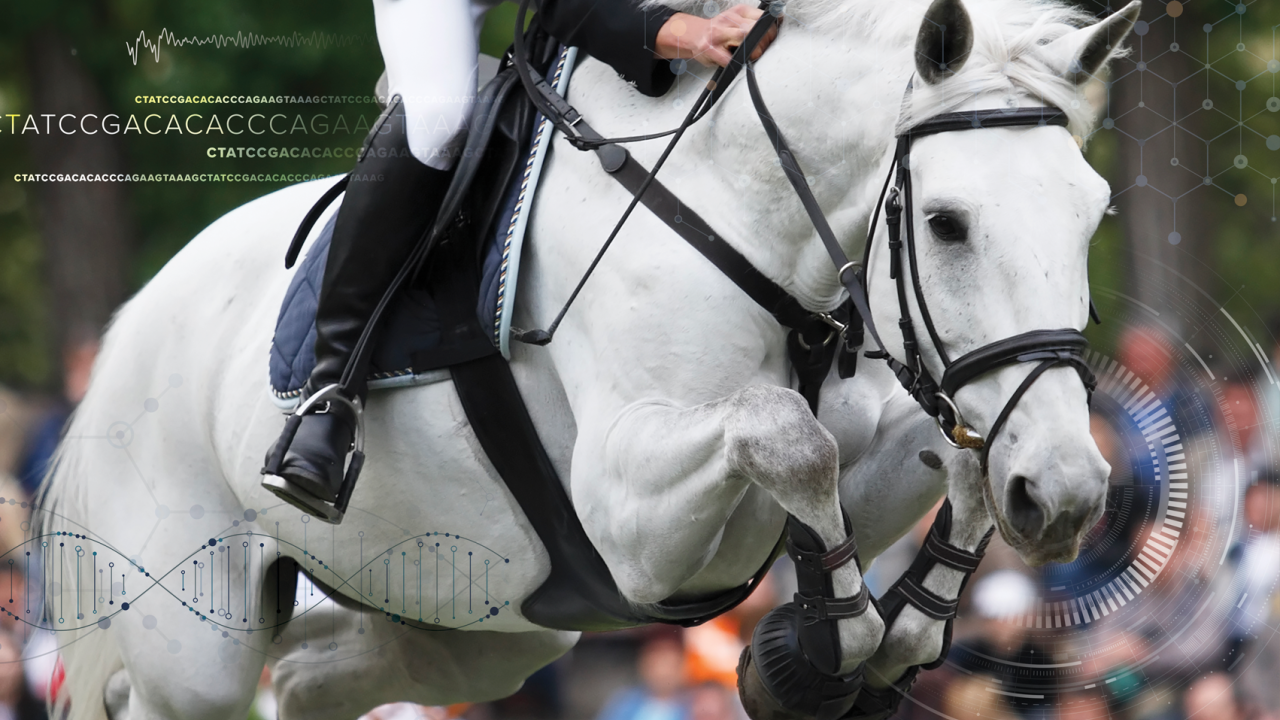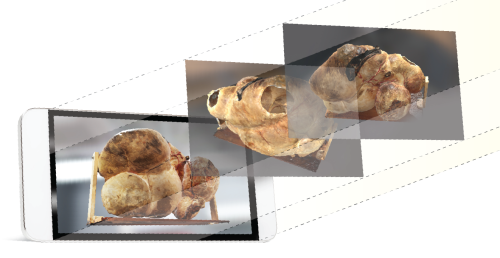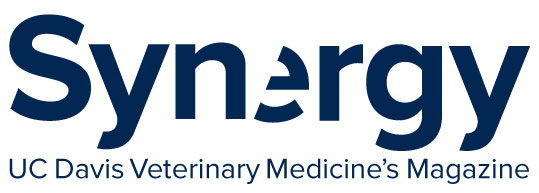
Envisioning the Future
From AI to Precision Medicine

After pioneering veterinary medicine for three quarters of a century, UC Davis is poised to take ambitious leaps forward. From artificial intelligence (AI) to precision medicine, technological advances are shaping the future of research discoveries, patient diagnosis and treatment, and the learning environment.

Exploring Artificial Intelligence to Benefit Animal Health
AI is already ubiquitous in our daily lives—through our smartphones, voice assistants, travel apps, ecommerce and much more. Technology that uses AI is also on the rise in other areas like healthcare. Using a data-driven approach, AI may be able to help doctors diagnose diseases more efficiently.
Dr. Stefan Keller, an assistant professor and pathologist, specializes in diagnosing animal diseases. A large part of his research is directed toward improving healthcare outcomes by using data to make more informed diagnostic decisions. To that end, Keller and colleagues from the school’s Artificial Intelligence in Veterinary Medicine Interest Group are exploring ways to use AI in three different projects.
In the first project, the group is developing a machine learning algorithm (called a “classifier”) that uses historical patient data to reduce errors in the interpretation of blood tests and avoid inaccurate diagnoses. The project—funded by the UC Davis Venture Catalyst Science Translation and Innovative Research grant program in 2022—is focused on identifying disease patterns in animals using laboratory data and AI tools, and helping clinicians consider different diagnoses.
We have thousands of standard blood work data from the past decades. If we take all that and run it through our algorithm, we can predict what disease the pets might have and what the prognosis might be.”
—Dr. Stefan Keller
While the initial application is for dogs, the team sees opportunities to adapt the tool for other species, including cats and horses.
In the second project, the team is investigating inflammatory bowel disease in aged cats to assess inflammation levels. In the current system using microscopes, there’s a discrepancy in how pathologists assess or grade inflammation. Training the classifier to recognize different inflammatory cells will allow standardization of inflammation assessment, which is important because it affects how clinicians treat patients.
This leads to the third project of hosting the classifiers on a platform to help with clinical decision making. Currently, scientists have to manually pull the data from a patient database onto a computer, run the classifier on that data locally, and then provide the information back to the clinician. Keller’s team is working to cut down that time-consuming, manual process by hosting the classifiers on a shared platform called Animal Health Analytics and feeding the patient data directly into it so the patterns can be detected in real time. The project is conducted in collaboration with the school’s Information Technology (IT) service and involves clinicians and colleagues including Dr. Krystle Reagan, who developed the classifiers.
In terms of AI adoption, Keller thinks veterinary medicine presents an interesting landscape, adding that training data is more easily obtained in veterinary medicine than in human medicine and so far, there are no rules around the use of AI algorithms for diagnostic use. However, the pitfalls of the technology and the attitude of users are very similar in veterinary and human medicine.Thorough testing, feedback and objective analysis will be crucial to successful adoption of new technologies.
“If you’ve done things the traditional way for decades, you might be reluctant to adopt an AI algorithm, and then believe in the results,” Keller said. “Transparency of the method is important but with many AI algorithms there is some black box analysis that comes into play, and that is potentially concerning for users. We have to see how we can address that.”
At the end of the day, we’re trying to provide the absolute best care and AI is just another tool that we have at our disposal.”
—Dr. Krystle Reagan

AI to Improve Client Experience
While the rise in technological advancements may seem to be occurring at a rapid pace, Reagan said clinicians have been incorporating new technologies into how they practice medicine since they started. For example, over the course of 300 years, the stethoscope has evolved from a paper tube to a horn-shaped instrument, to a binaural stethoscope, and finally to an electronic form.

“Now that we have stethoscopes that have AI built into them to amplify the sound of heart murmurs, we’re adopting those because it is the best thing for our patients,” Reagan said. “At the end of the day, we’re trying to provide the absolute best care and this is just another tool that we have at our disposal.”
As an internal medicine specialist, Reagan’s research focus is in the assessment of novel therapeutics for companion animal infectious diseases such as feline infectious peritonitis, as well as the development of rapid diagnostic tools that may use AI for clinical decision making. (Read more about these AI applications in Clinical Updates here.)
Reagan says AI can help veterinarians meet the workload explosion by serving as a scribe in the exam room, scheduling patients, and triaging the urgency of client phone calls. She also anticipates that AI will be used in the future to help take a patient’s medical history before the client shows up at the hospital.
“We’re exploring various ways to address client concerns, get to the bottom of an issue more quickly and improve the veterinarian’s satisfaction with history taking,” Reagan said.
Precision Medicine
Precision medicine is also on the horizon for veterinary patients in much the same way it is now being applied in human medicine. This is an emerging approach for disease treatment and prevention that takes into account individual variability in genes, environment, and lifestyle. Clinicians may use precision medicine to help identify people who may be at high risk for particular cancers or it can be used to determine which tests and treatments are best.
Precision medicine is an emerging approach for disease treatment and prevention that takes into account individual variability in genes, environment, and lifestyle.


Dr. Robert Rebhun, veterinary oncologist, sees this approach evolving in veterinary medicine. He collaborated with Dr. Robert Canter, a human surgical oncologist, to conduct a novel clinical trial on an inhaled immunotherapy drug for dogs with cancer that had spread to the lung.
The dogs were treated with protein interleukin-15 in an effort to trigger the body’s defense mechanisms—T-cells and natural killer cells—to respond and destroy invading cancer.
Tumors shrank dramatically in two of the 21 dogs enrolled in the study, including one that went into complete remission for more than a year. Cancer that had been growing rapidly in five other dogs stabilized for several months.
“We had some amazing responses, but a lot of dogs didn’t respond,” Rebhun said.
“The question is why. The next research study (recently funded by the National Institutes of Health) will allow us to look specifically at not only what the genetic pathways look like in canine osteosarcoma, but what the baseline immune system looks like.”
That knowledge will allow Rebhun and other veterinary scientists to better predict which dogs may do well with that specific inhaled immunotherapy or allow them to customize immunotherapies for treatment.
“The more we learn every year about mutations in canine, and even feline cancers, and the apparent pathways that have led to particular tumors, the closer we are to using that information to improve patient outcomes,” he said.
In the future, genetic data and advanced diagnostics could be used to tailor medical treatments to an individual horse’s genetics, its environment, and the interactions between the two.
—Dr. Carrie Finno
Dr. Carrie Finno’s laboratory has partnered with the school’s Center for Equine Health (CEH) and Platinum Performance on the “Pioneer 100 Horse Health Project,” a first-of-its-kind precision medicine study in horses. The project has been gathering data, including whole genome sequencing, on 100 CEH teaching herd horses who live at the center. The goal is to be able to create a scientifically sound wellness program using a combination of multi-omics (genomics, proteomics, metabolomics, etc.) approaches focused on disease prevention.
The advantage of using this population to establish a database is that researchers have access to their medical records and can control many aspects of their environment, such as their diets, limiting variables in a way that would not be possible if horses were housed at different locations. In addition, the majority of these horses are long-term residents, meaning that researchers can follow their health and associated data over time.
“In the future, genetic data and advanced diagnostics could be used to tailor medical treatments to an individual horse’s genetics, its environment, and the interactions between the two,” said Finno, an equine internal medicine specialist and veterinary geneticist who serves as the CEH director. “Data from this project could help evaluate, for example, how a particular patient is likely to respond to one drug versus another, making it possible to target treatments for the most successful outcomes.”
We’re able to connect people through technology with resources that we used to think of as anchored in a specific space.”
—Dr. Joie Watson
Enhanced Learning and Assessment
When the COVID-19 pandemic forced classes to go remote for a period of time, it highlighted the need to adapt technological innovations for engaged remote learning. Dr. Joie Watson, associate dean of professional education, said anatomy instruction was one of the first things that came to mind in exploring how technology could support the DVM curriculum.
Justin Ross, multimedia developer on the school’s IT team, collaborated with Colorado State University—who has been developing 3D virtual learning for the past several years—to create the 3D Virtual Reality Project for UC Davis. With the help of Sketchfab (a 3D modeling platform), the project offers a way to explore assets that once would have only been available in a laboratory space—specimen samples like an equine femur, elephant skull or a bovine rumen.

3D modeling platform, a student can explore
the outer surface and then travel inside
Some of those assets, like the cow specimen, are old and fragile and in danger of falling apart. Watson explained that this technology allows them to be preserved for many more people to access and learn from over the years, from any location.
The 3D specimens can be viewed on any mobile or desktop browser, or virtual reality headset. When looking at the cow rumen, a student can explore the outer surface and then travel inside, much like taking a ride on the Magic School Bus.
This approach allows visibility from anywhere and safeguards valuable assets that are difficult to find and put together.
“We’re able to connect people through technology with resources that we used to think of as anchored in a specific space,” Watson said. “The future may involve students being in a virtual reality space and a teacher could be there simultaneously accessing a resource together. We’re not there yet, but that’s part of what we see as the possibility.”
Capturing learning moments during clinical rotations at the veterinary hospital is another area where Watson said technology will come into play. In a dynamic hospital environment where clinicians are busy, talking to clients and taking care of animals, there isn’t much time to check off boxes on a skillset assessment for students.
So, the IT department has put together a brief assessment tool, to be used on a cell phone, that they hope to pilot soon. Within the app, clinicians can enter comments using talk-to-text transcription and links to “just-in-time” assessment. In this way, faculty members can provide feedback in a way that is seamless.
“Students are always looking to improve toward Day 1 competency after graduation,” Watson said. “This tool will help enhance their learning.”
Neelanjana Gautam from the UC Davis Office of Research provided the reporting on Dr. Stefan Keller’s work.
